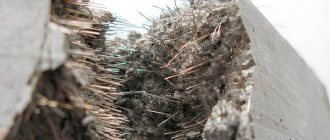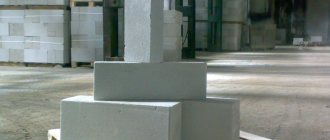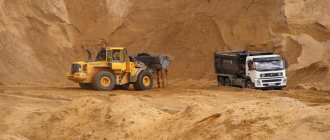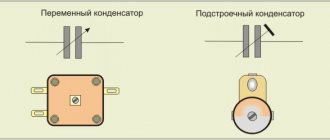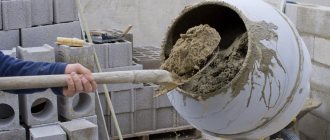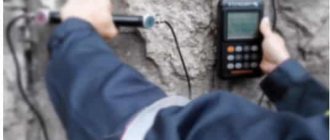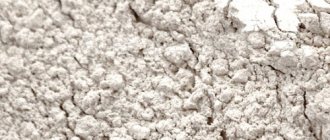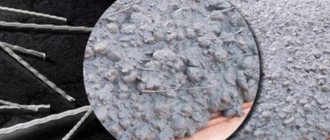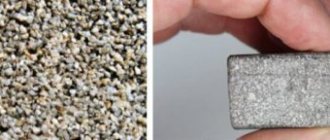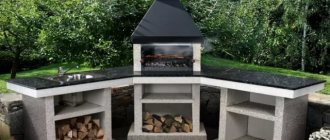Kevlar concrete composition
This building material includes the following components:
- mineral fillers of medium and coarse fractions, including those with clay inclusions;
- screening of granite of different fractions, basalt, dolomite or crushed stone;
- fine-grained sand;
- cement;
- plasticizer S-3 or SP-1;
- water (about 17% of the total mass);
- dyes (usually iron oxide, phthalocyanine pigments or carbon black are used).
In general, the basic set of components of Kevlar concrete is the same as for the preparation of other types of heavy concrete. The difference is in the technology of its production.
Component proportions for Kevlar concrete
During the preparation of the solution, so-called concrete pellets appear, adhering to granite or other filler. Inside them are sand grains, screening fractions and cement in the center.
After such balls are unloaded into molds, small particles flow together and form a single mixture, while larger ones form a rigid frame, giving the material special strength characteristics. Kevlar concrete consists of individual elements up to 5 cm in size and small particles (up to 2 cm) connected into a single whole.
Composition of Kevlar concrete - main components and additional components
In general, considering the composition of the mixture in a deeper sense, it should be noted that this type of concrete consists of individual pellets presented in the shape of an ellipse. When analyzing a section of such material, nuclei of varying sizes not exceeding 5 mm are clearly visible in it; in addition, there are individual inclusions of smaller particles in size not exceeding 2 mm. Around the cores, both large and small, there is a sealing material consisting of a mixture that is part of the building material (cement, screenings and sand). Thanks to its composition, Kevlar concrete has high compressive strength, resistance to low temperatures and temperature changes, as well as increased gas impermeability and the lowest level of wear possible for similar materials.
Classification of concrete
Depending on the additives and fillers, concrete can have different properties. There is the following classification of materials:
- by density - especially heavy, heavy, light, especially light;
- by structure - dense, porous, cellular, large-porous;
- by area of application - general purpose, structural, thermal insulation, self-expanding, grouting, heat-resistant, decorative, etc.
Technical characteristics and properties of Kevlar concrete
The minimum strength grade of Kevlar concrete is M600, or class B45. Thus, its ability to withstand a compressive load is 600 kgf/cm².
Important! Unlike simple concrete, which can withstand up to 50-150 cycles of defrosting and defrosting, for Kevlar concrete this figure is an order of magnitude higher - F700.
The surface of the material is smooth, glossy. Using special pigments, it can be painted in any shade, and the consumption of dyes will be 2 times less than for pigmenting classic solutions.
The water saturation of Kevlar concrete is 0.5% (the norm is less than 5%). When in contact with snow or water, Kevlar concrete has a slip close to zero.
Compared to concrete products that were produced in the usual way (vibration casting), pelletized building materials have much greater reliability, decorative properties, and better physical and chemical properties. It has high gas permeability and minimal wear.
Production technology using the gravity clumping method
The method of producing Kevlar concrete is very different from classical concreting technologies and requires strict adherence to recommendations.
Sequencing
Before placing the material in the mold, you need to prepare a dry mixture and make pellets with a diameter of 2 cm to 5 cm. The intermediate product consists of many oval-shaped lumps.
Placed in a mold, the pellets are vibrated, and then the formwork is stripped and the products are dried. The result is a monolith without air inclusions.
Materials
To obtain high-quality products, use Portland cement grade M400-M500 or higher (50 kg). Also prepare:
- river or quartz sand of a fraction of 1.5-2.5 mm without impurities, dirt (any sand with a content of clay components of no more than 2.5-3%) is suitable - 150 kg;
- granite crushed stone or gravel with a grain of 2.5-5 mm - 250 kg;
- plasticizer based on sodium polymethylene naphthalene sulfonate (for example, Relamix N) - 0.5 kg;
- water – up to 17% of the total volume;
- additives to accelerate setting (organic monomers);
- coloring powder of the chosen color.
Granite crushed stone
You can use different color combinations to color the solution. With incomplete mixing, it is possible to achieve a structure reminiscent of that of natural stones: malachite, marble, granite, etc.
Equipment
For the production of Kevlar concrete, gravity-type concrete mixers are used - machines with a rotating and tipping container (pear). On the body of the device there are fixed blades, which, during the rotation of the pear, capture the mixture and lift it upward.
At the highest point, the solution breaks off and falls down. Thanks to the rotation of the pear, the concrete turns into pellets. In addition to such a concrete mixer, a vibrating table and plastic molds are used for production, the bottom of which imitates the structure of one or another natural material.
Kevlar concrete manufacturing techniques
Dry ingredients are mixed for no longer than 1 minute. Separately, pigment, plasticizer, and additives are dissolved in water. To save money, you can add dyes only to the top layer of concrete. Pour liquid into the mixture in a thin stream and put the unit into operation.
When ready, the pellets are inspected and broken down to assess their composition and structure. Then the material is placed in molds pre-installed on the vibrating table.
Vibrate until the mass is completely compacted. Raw products are kept in molds for at least 24 hours, then removed and left for another 5 days. After the specified period, Kevlar concrete will become strong, reliable and durable, will meet all stated requirements and can be used for its intended purpose.
Complete Granilite technology - training in the production of concrete products
We invite you to purchase a production franchise using Granilit technology. Granilite is a technology that allows the production of concrete products with improved qualities of the front surface, which do not require putty, with minimal consumption of expensive pigment. The franchise involves opening your own profitable enterprise that produces concrete products (paving stones, paving and parapet slabs, sculptures, etc.) using pellet granulation technology. This technology increases the level of physical, technical and aesthetic characteristics of concrete products. The expected level of profitability of production is 200 - 400 thousand rubles. It itself is organized in a week, and pays for itself in about six months.
The essence of Granilit technology
Granilite is a technology that allows the production of concrete products with improved qualities of the front surface, which do not require putty, and with minimal consumption of expensive pigment. This quality is achieved by the specifics of pellet granulation technology. This technology uses a modified concrete mixer to form pellets. Pellets are essentially small balls with a core formed from the largest fractions of granite screenings. When molding concrete products under the influence of high-frequency vibration, the pellets are combined into a high-strength monolith, creating a rigid lattice structure. Products made from Granilite have higher strength indicators than those of conventional concrete. The manufacturing technology of Granilite was borrowed from ferrous metallurgy technologies.
Franchise goal
The Granilite production franchise will allow you to organize your own profitable concrete production based on our technologies. Production is organized in one week. Pays for itself in six months. Production profitability is about 250 - 300 thousand rubles.
By purchasing a franchise, you also receive a package of technologies for the production of the following products:
- Paving materials (paving stones, paving slabs, gutters, etc.)
- Materials for ritual purposes (monuments, obelisks, flower beds, paving slabs, etc.)
- Fencing elements (posts, fence sections, etc.)
- Facing materials (siding, facing tiles, artificial facing stone, etc.)
- Small architectural forms (sculptures of people and animals, flowerpots, bas-reliefs, etc.)
- Finishing materials (parapet slabs, overhead treads, risers, etc.)
Video example of manufacturing a prefabricated fence section
Stages of training for the Granilit franchise
Granilit franchise training takes place on the basis of an existing enterprise at its production facilities. The student will become familiar with production from the inside using the example of a successfully working model. Granilit franchise training takes two days, during which the student will sequentially go through all stages of the production hierarchy: from the pouring worker to the production manager.
Stage I. Practical.
At the first stage, the student, under the guidance of a specialist and with his accompanying comments, observes the production, and then directly takes part in the production of products from Granilite. At this stage, there is an acquaintance with the technology and algorithms of concrete production: the specifics of mixing the solution, the features of molding, the nuances of the conditions of storage and transportation of finished products, etc. Throughout the entire practical part of the training, the student learns from his own experience all the intricacies of Granilite technology. Will see the specifics of organizing the workspace and the peculiarities of interaction between workers in production. He will learn how to mix the components of the solution and achieve the required color scheme for the products, as well as how to pour the solution into molds and unmold it correctly. The accompanying specialist fully controls the process, helps, notes errors, and also suggests ways to eliminate them. By the end of the first day of franchising training, concrete products made by the student himself must meet all technological, quality and aesthetic requirements.
Stage II. Theoretical.
The second day of training under the Granilit franchise is entirely devoted to a theoretical study of the process of manufacturing concrete products and organizing a working concrete production. At this stage, the student becomes familiar with the digital specifics of the production process. What equipment does a beginning manufacturer need to purchase? What quality and specificity should the raw materials used be? Exact proportions of the components of the concrete mixture. The aspiring entrepreneur will also receive a base of suppliers of equipment and raw materials. All technical production schedules will be attached in printed form to the package of training documents.
Assistance to a company learning to franchise in organizing their own production.
After completing the franchise training, the trainee will be guaranteed lifetime consulting support. It includes: consultations on all technological and organizational issues, as well as assistance in finding customers.
Information and documentary support for Granilit franchise training
- Conclusion of a formal agreement that specifies the rights, obligations of the parties and guarantees.
- Printed materials with recommendations for starting production from scratch, as well as training in the specifics of selling concrete products.
- Video and photographic materials for filling websites and booklets.
- A package of technological documentation for Granilit (equipment layout diagrams, requirements for the organization of labor and for the operation of equipment in concrete production, recipes for concrete mixtures, technical characteristics of finished products, instructions for installing paving and cladding materials).
About company
The LOBAS company has been operating on the concrete products market since 2005. We entered the market with technology for the production of marble slabs from concrete. This is an incredibly popular and aesthetically attractive type of concrete product. Active customers of this building material then and still are the owners of cottages and country houses. Our marble tiles make any architectural design exclusive, making it stand out from the rest of the building. Since 2007, we began to expand our production range through the production of plastic molds for concrete products, and subsequently through the production of equipment. Now our enterprise is a full production cycle enterprise. The product of our plant goes through all production stages within it, from the idea and 3-D model to mass production and pre-sale preparation.
All our products undergo mandatory certification and quality control. Since 2008, we have been fruitfully cooperating with foreign manufacturers of concrete products, teaching them proven and latest technologies for producing concrete.
At the end of 2021, a Serbian citizen successfully completed training in Marble from Concrete technology. Within three days of practice and one day of theory, I received all the necessary theoretical and practical information to organize my own production in Serbia.
